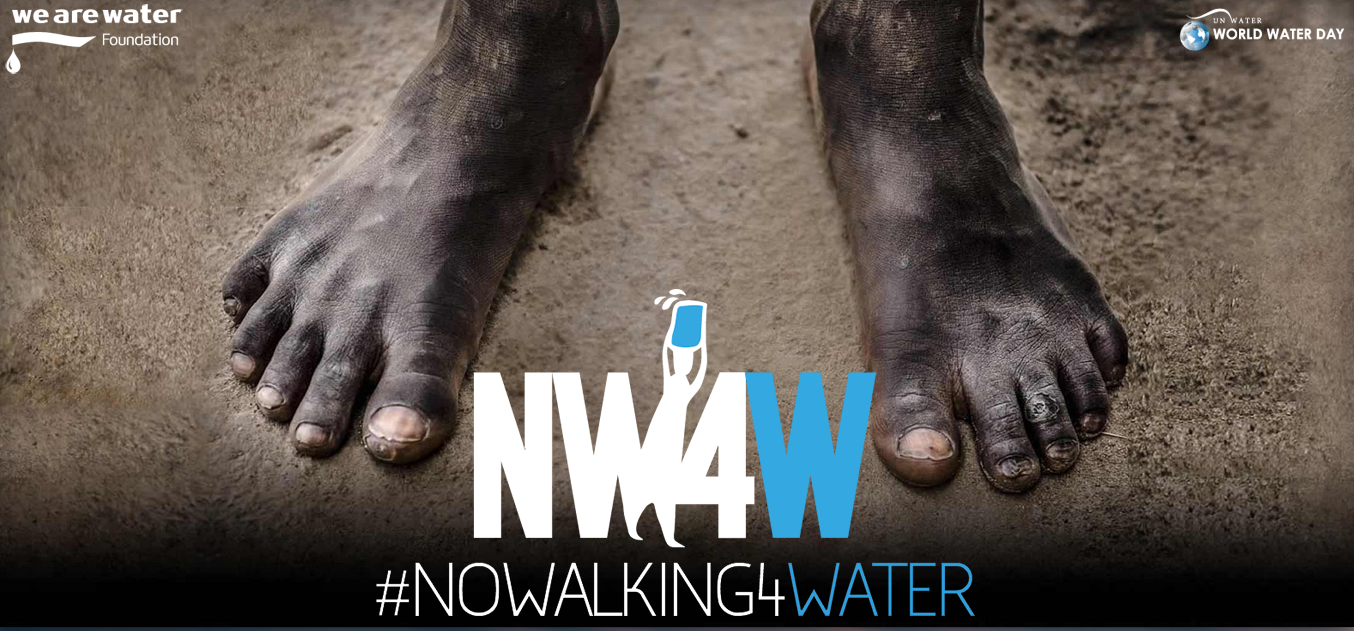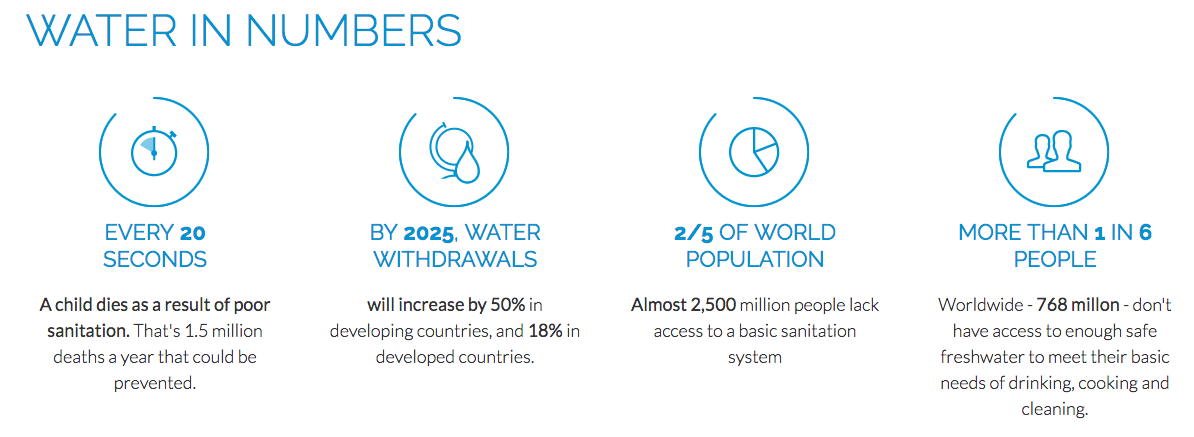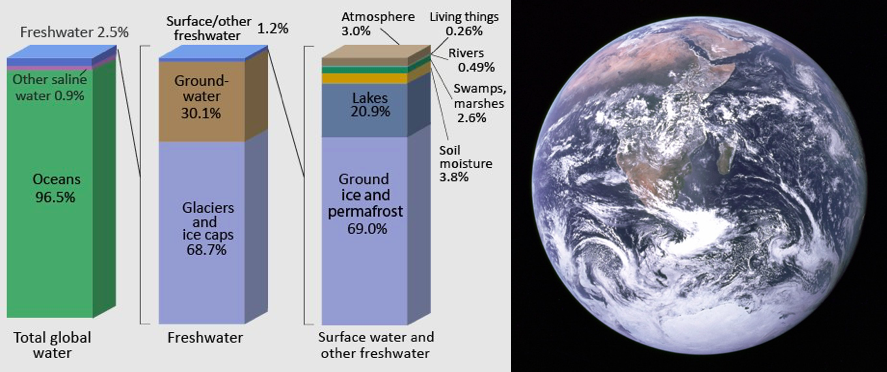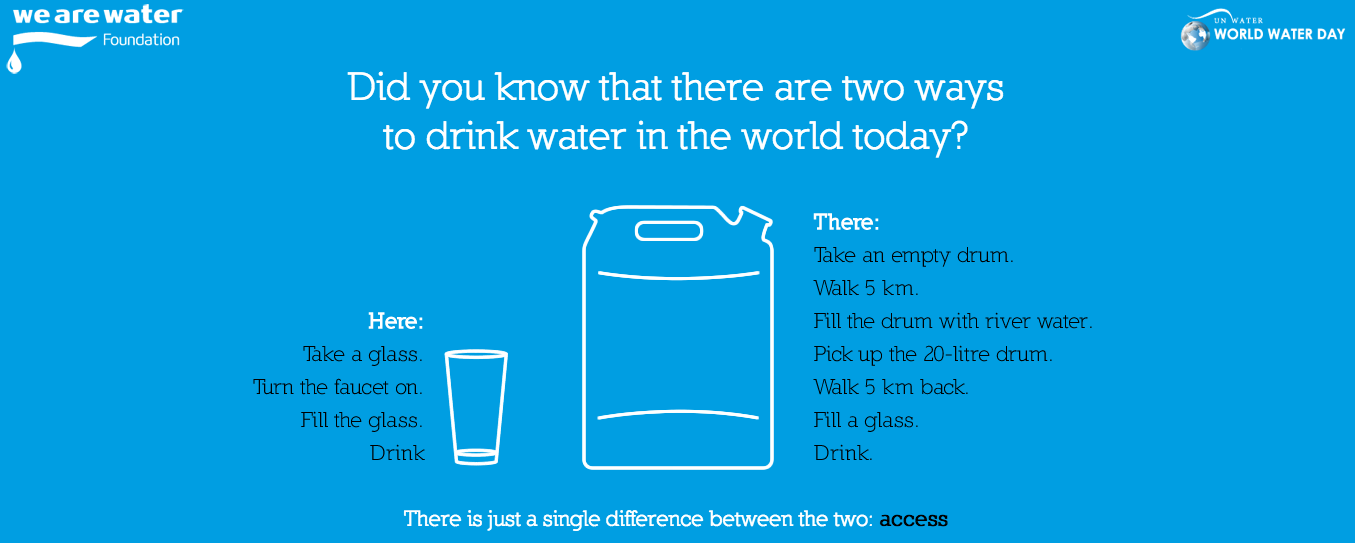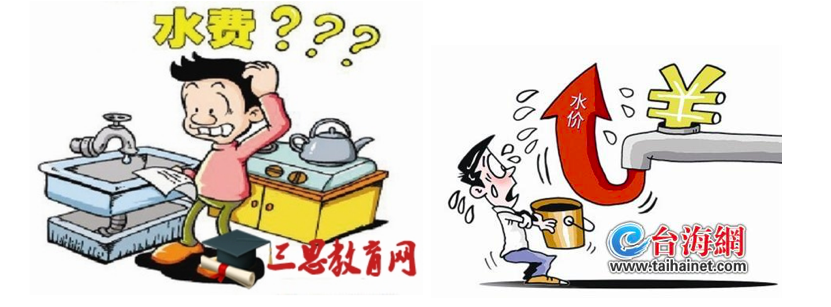Sanitary appliances manufacturer Roca, headquartered in Spain and active in 135 countries, sponsors the WE ARE WATER foundation, which promotes a new water culture that allows the sustainable management of water resources around the world and guarantees the universal human right to access water and sanitation needed for a dignified and healthy life. It’s campaign #NoWalkingForWater encourages us to draw upon man’s single most important spiritual resource, kindness, to provide those in need, man’s single most important physical resource, i.e. water. I couldn’t think of a more purposeful undertaking, but on a fair note, I have to remind, that many others have had this idea before Roca, like e.g. Dane Charlie Uldahl Christensen, who is on his 672th day of a pilgrimage to raise money and awareness for water.
Why is that? Water covers 71% of the Earth's surface, but the oceans contain 96.5% of the Earth's water, which is not potable. The Antarctic ice sheet, which contains 61% of all fresh water on Earth, is visible on the bottom of below Earth’s view from Apollo 17. It is, like the ice caps of Greenland or the glaciers of Iceland not accessible to human use. Condensed atmospheric water can be seen as clouds, contributing to the Earth's albedo, makes up for another 3% of potable water, leaving mankind with a comparable small volume of 0.0007% of freshwater only, which can be found in rivers, lakes, swamps and soil.
One could also point at the increased use of desalination technology to solve the problem of freshwater scarcity. According to the International Desalination Association, in June 2015, 18,426 desalination plants operated worldwide, producing 86.8 million cubic meters per day, providing water for 300 million people.[5] This number increased from 78.4 million cubic meters in 2013,[4] a 10.71% increase in 2 years. The single largest desalination project is Ras Al-Khair in Saudi Arabia, which produced 1,025,000 cubic meters per day in 2014,[4] although this plant is expected to be surpassed by a plant in California.[6] Kuwait produces a higher proportion of its water than any other country, totaling 100% of its water use.[7] The downside of desalinating sea water is that it is generally costlier and more energy intensive than the treatment of fresh water from rivers or groundwater, water recycling and water conservation. Just think that you have to build for each large desalination plant a small nuclear or a large photovoltaic power plant next door.
Tongji University’s Prof. Li Fengting, Executive Deputy Dean at the UNEP Tongji Institute of Environment for Sustainable Development, was not available for his scheduled talk. One of his research assistants, Dr. Wu Yinan, presented instead how Shanghai upgrades its waste water treatment facilities and develops new waste water treatment technologies. He failed to provide basic numbers to understand the dimension of this challenge on a global, national and municipal level. But it worried me mostly that there was not a single reference to the reduction of water consumption. China is at a stage in its economical development, at which Western nations can’t expect the behavior of an economy which has already undergone 250 years of industrial revolution, but one would have wished that the UNEP Tongji Institute of Environment for Sustainable Development to present a bit more far sighted perspective on how things develop and what needs to be done apart from re-engineering water treatment technologies, which probably are already available abroad.
Shanghai is endowed with water in abundance and has hence grown into one of the largest agglomerations on this planet. Yet this abundance is threatened. All of Central and large parts of Western China drains its waste water into the Yangtze and Shanghai chokes as its dragon head on the accumulated toxins. The city’s wealth has been mocked in 2013, when more than 13000 dead pig floated in Huangpu, as paradise with pork broth freely available. Shanghai residents who have lived in other parts of the world notice that their fingernails grow faster, probably due to growth hormones in the tab water, which can’t be removed by filter or boiling. Same is true for antibiotics widely used in pig farming, which are scientifically associated with causing autism, a disease virally on the rise in China.
Now, this sounds as if Shanghai is not a sound place to live, and yet I am day by day amazed how a city of such scale operates quite smoothly. It's a miracle that millions of people commute from A to B, have electricity and above all potable, albeit polluted, water. Have you ever stopped on the sidewalk when construction workers are busy down in one of those deep sewage pipes? The complexity of these sewage systems is mind staggering and I am in full awe that the city government is able to run this place. The question is then, what we can do, to make such already incredibly complex urban areas run smoother and more sustainable?
China currently treats only 10% of its waste water and discharges 90% untreated into its water bodies. This ratio is reversed in countries like Germany or Japan, but China is not alone with such infrastructure problems; environmental pollution is certainly a global issue which increases in correlation to population density. And since water bodies do not know national borders, we have to acknowledge that waste water production and freshwater provision are not domestic, but regional if not even challenges of global scale on which mankind has to collaborate in friendly partnership.
The excellent Western Wetland Museum in Hangzhou is a marvelous location to learn about the China Water Tower, the highlands of Tibet and Qinghai which are the main freshwater resources for Asia’s three mightiest rivers, the Yangtze, the Yellow River and the Mekong. A recent visit to the museum drew my attention yet again to China’s extraordinary responsibility of water management, not only in regard to its own population, but in regard to most of Asia’s population. Dr. Wu’s talk sadly showed that researchers at elite universities like Tongji do not look into how to manage water more sustainably or distribute it more fairly, but rather how to manage increased consumption and increased pollution with new technologies. The latter is an important measure without doubt, but it will not be the problem’s single solution. Although he promoted his institute’s work with the slogan green is gold, green is priority, not GDP, it seems that China is in a macroeconomic trap, from which researchers can’t escape: how is it possible to build a society, which until recently was predominantly agricultural and enjoyed a spree of three decades manufacturing madness for the rest of the world, into a domestic consumer society with an annual GDP growth of at least 6% to maintain social stability? There is no domestic solution to this question. China will have to make a choice between increased consumption and less pollution, not only for the sake of its citizens, but for the sake of mankind. And each one of us must make a choice in favor of individual or macro economics, that is economics as if people mattered or economics as if power mattered.
Reducing Water Consumption and Waste Water Generation
The evening’s second talk by Mr. Wang Enxue, an experienced water engineer who works for the Netherland based NGO Solidaridad in China, came much closer to this solution. Solidaridad maintains a strong presence in the country to ensure that China continues to develop as a sustainable market and responsible investor, and Mr. Wang reminded us that the production of a single T-Shirt consumes 2700 liters of water, the equivalent of roughly ten bath tubes. Awareness about water consumption starts with an understanding on how we consume water not only directly, but more importantly, indirectly.
Water consumption is quite similar to human consciousness, consisting of a conscious and of an unconscious part. There is the water which we see and taste, which goes down our throat as nourishing liquid, which cleans our bodies, rinses our dishes or flushes our intestine’s discharge. And then there is the water which we are not aware of, because it is hidden in a product like a cool piece of clothing, a dry snack or a journey to the Maldives. There is literally no single activity which does not imply the consumption of water. We just don’t pay attention, because we are not aware.
A chart with obvious and less obvious typical water consumption would therefore be a good start to raise awareness on how to use this precious resource. One will come to the conclusion that a daily shower is less harmful than the daily usage of makeup. One will be able to confirm what GI founder Nitin told us during the fade out of the evening, that eating less meat makes much more difference than trying to rinse one’s dishes manually and efficiently. It would be great if GI could follow up on this.
So, what to do as a consumer? Pee while having a shower to save a flush? Step back from one’s vanity and let go of cosmetics and fashion products? Are we supposed to run around in rags? Or should we follow the Buddhist teaching and refrain from eating meat all together? I certainly see a light at the end of the tunnel | 否极泰来 as the Chinese say, when we look more inwards for salvation | 回头是岸。We will recognize that the state of our bodies and minds is reflected in the condition of our environment.
Think for a second about the Zen koan about the glass of water as a metaphor of our body, respectively our mind; quite a brilliant analogy, considering that ancient Zen masters did not yet know that the human body is made up by 2/3 of water. The disciple asks the master: How do I attain Zen? The master answers: Pour me some more tea and I will show you. The disciple does as he is told, but the master does not let him stop to pour tea into his cup when it is already full. The brew spills all over the table, and in this moment the student attains Zen.
This koan tells us that we have to first empty our bodies and our minds in order to be capable of receiving insight and wisdom; even more so if our bodies and minds are physically and spiritually polluted. It teaches us in our modern consumer societies an additional lesson about physical and mental consumption, about questioning the necessity to purchase yet another designer jacket or watch yet another soap or check yet another time on our phones if we received a new message, while there are more important things to do like listening to a friend or helping those at the other end of the world, who don't even have enough water to drink.
In a world which is built on kindness, we would not judge each other for our looks, but for our deeds. There would be no need to go at great lengths and vast expenses to dress and make up. In a world which is built on kindness, managers at Veolia and Suez would convince Middle Eastern governments to finance one desalination plant in African drought zones for each plant they purchase for themselves. In a world which is built on kindness, we do not need to waste enormous public budgets on national security and national defense, but invest these funds into technologies which promote life rather than threaten to destroy it. In a world which is built on kindness, East and West, North and South, every man and every woman under heaven would put their bodies and brains into the service of the greater good not only those tribes they are attached to by bonds of family, organization or nation.
***
Follow up resources:
Listen:
- Sinica: Water on the Brink
- Sinica: The South-North Water Diversion Project
- Sinica: In Line Behind a Billion People
- In a Line Behind a Billion People - How Scarcity Will Define China's Ascent in the Next Decade by Damien Ma and Willam Adams
- Small is Beautiful – Economics as if People Mattered by E. F. Schumacher
- Hangzhou Wetland Museum: http://sdbwg.hzxh.gov.cn/
- China Energy Conservation and Protection Group: http://www.cecic.com.cn/
- Planeat: documentary about nutrition’s impact on our health and the health of planet Earth
